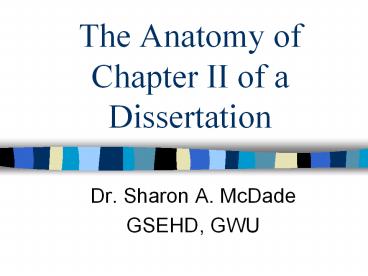The Anatomy of Chapter II of a Dissertation PowerPoint PPT Presentation
1 / 21
Title: The Anatomy of Chapter II of a Dissertation
1
The Anatomy of Chapter II of a Dissertation
- Dr. Sharon A. McDade
- GSEHD, GWU
2
Types of Literature Reviews
- Annotated bibliography
- Bibliography critique essay
- Short format lit review
- Long format lit review
3
Purposes of Literature Reviews
- To trace the history of a topic
- To investigate the scope of a topic
- To provide a context of theory related to the
topic - To assess previous research
- To assure the reader that the researcher has a
full grasp of the subject
4
Purpose of Literature Review in Dissertation
- To justify selection of the problem
- To aid in the selection of research methodologies
- To address duplication
- To generate a bibliography
- To convince the committee that the researcher has
a grasp of the big picture - To build the foundation for the research
instrument
5
Parts of a Literature Review
- Introduction
- Purpose
- Definition/limitation of the topic
- Criteria for inclusion/exclusion
- Body
- Conclusion
6
What You Need to Get Started
- Most up-to-date computer you can afford
- Endnotes software
- Most recent version of your preferred word
processing software - Access to WordPerfect (for the grammar checker)
- Filing cabinet, file folders
- Notepad
7
More of What You Need
- Participation in at least one library tutorial
session on searches - Library copy card
- A dedicated desk/work area
- A door that closes against rest of world/family
- A colleague who will read and critique
8
Steps of the Process
- Figure out the topic/s of the review
- Write a definition/problem statement
- Determine the variables for follow-through
- Peruse the secondary sources
- Select an appropriate index and do a trial run
9
More Steps of the Process
- Expand your search to related bibliographic
databases and indices - Read and take notes
- Collect bibliographies
- Search for the primary sources behind the
secondary sources - Write often
- Get lots of feedback
10
Notes on Process
- Review versus reproduction
- Assertions
- Reinventing the wheel
- Style of writing
- Finding your own voice
11
Organization
- The first organization of the lit review is never
the best one - Experiment with several organizational formats
- A solution but not the best one--Put it all in
and let your chair give you guidance
12
Dont Forget
- Each major section is a paper unto itself
- Introduction
- Body
- Conclusion
- Each paragraph needs a
- Topic sentence
- Concluding sentence
- Dont cheat a conclusion of one section by
introducing the next topic
13
The Circle Method of Concept Organization
Tasks
Women
Theory
Leadership
Vice Presidents
Tasks
Develop ment
Career Develop ment
Paths to Presidency
Measure ment
Higher Education
14
Finding the Good Stuff
- How to start? Start
- Where to start? Anywhere
- What should be included? Initially, everything
- Why cant I find much? You havent looked long,
hard enough
15
More on Finding the Good Stuff
- When have I looked enough? When you come back on
yourself - How far back in the lit should I go? As far as
necessary - How many references are enough? When youve read
the majority - Why do I have to read what I wont be including?
So you know its there
16
Even More . . .
- How many primary sources? Virtually all
- How can I keep track of my reading? Try Endnotes
- Do I need to tell about the studies that I cite?
For the key studies - Long long should it be? Long enough (find out
what your chair thinks is an appropriate length)
17
The Biggest Trap
- Jones said . . .
- Smith said . . .
- Hudson said . . .
- Booth said . . .
- And then Jones again said . . .
18
Hints for Success
- Take advantage of resources available to you
- Keep a log of key terms
- Think of it as small sections instead of one big
project - Use all of the capabilities of your computer
- Take advantage of the groundwork laid by others
- Look at other dissertation lit reviews on your
topic
19
More Hints for Success
- Record a complete citation for everything you
read (Endnotes helps) - Be clear in your note taking
- Keep everything in one place
- Tell others what you are working on
- Contact researchers in the field (only after you
really know what you are talking about!)
20
How Not to Insult your Chair
- Do not submit a draft that has not been properly
formatted - Do not submit a draft that has not been
spell-checked - Do not submit a draft that has not been grammar
checked (Microsoft Word grammar checker is a weak
eye) - Use APA style format, citations, headings
- Do not submit a draft that has not been read and
critiqued by a colleague
21
How It All Fits Together
Research Questions 1 2 3 4 5 Etc. Chapter I
Literature Review Section 1 Section 2 Section
3 Section 4 Etc Chapter II
Theoretical Constructs Chapter III
Items On Data Collection Instruments Chapter III
Data Presen- tation Chapter IV
Data Analysis Chapter V
Con- clusions Chapter V

